How to Make Pissaladière
This post may contain affiliate links. Please read my disclosure policy.
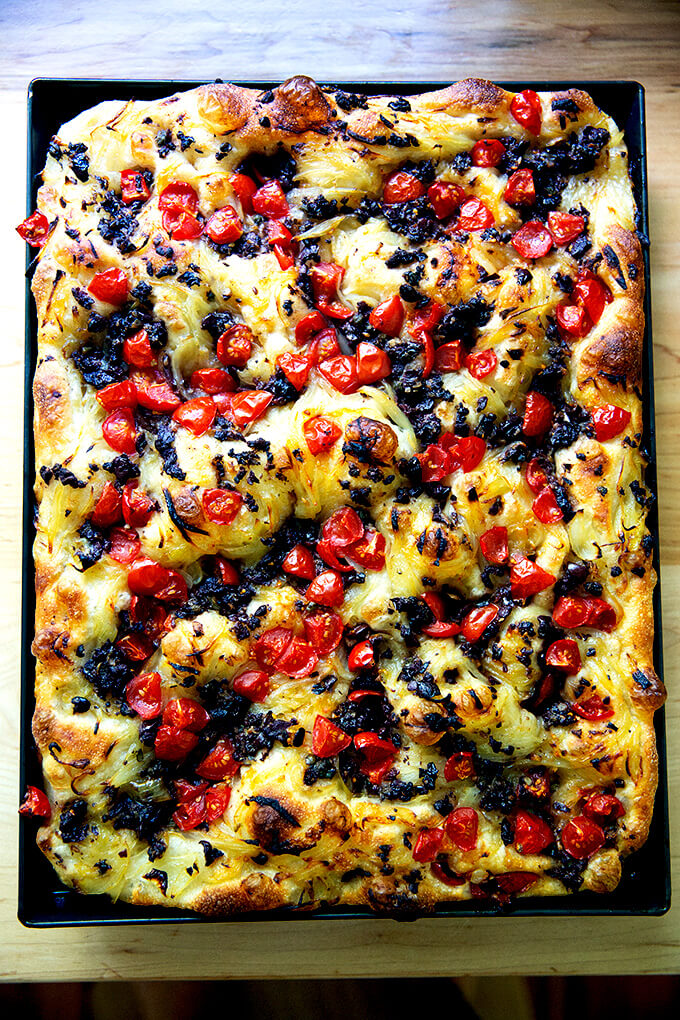
For the past few weeks, in place of our usual Friday pizza, I’ve been making pissaladière, the Provençal tart smothered with caramelized onions, anchovies, and olives. I add tomatoes to mine, too, perhaps to make it more pizza-like, but also because they just work, especially in the late summer and early fall, and truly, to me, there are few combinations more delicious. It’s like pasta Puttanesca in bread form, all sweet and salty, oily and briny, bold and aromatic.
Traditionally, atop the blanket of caramelized onions, anchovies are arranged in a crisscross diamond motif with olives either marking the intersection of anchovies or the center of the diamonds they create. I’ve never loved this geometric arrangement and so I make an anchovy and olive (and garlic and caper) paste instead. I like this approach for a few reasons, namely because it more evenly disperses the intense (umami!) flavor across the dough, but also, in some ways, because it disguises it: those who think they dislike anchovies won’t know they’re there.
I also have always loved the organic look of toppings scattered all about, though I must admit: the explosion of focaccia art cropping up across the web these past few years had me thinking: Should I revisit the iconic pattern? Is pissaladière the original focaccia garden?
It turns out: no!
I was shocked to learn from this Saveur article that pissaladière gets its name from pissalat, a pungent anchovy paste. According to the article, pissalat is made by layering baby anchovies and sardines with salt, spices, and herbs, and fermenting the mixture for 45 days. Early versions of pissaladière called for spreading the fish paste over the dough before layering onions over top.
Interesting, right?
Regardless of how you choose to pissaladière, there are a few key elements to include, which I explore below, but first:
How do you pronounce pissaladière?
Who knows?! Many moons ago, my brother-in-law gave me permission to never worry about saying it correctly when he declared the pizza-like assembly before him: pizza-derriere! I’ve never been able to say it any other way.
Pissaladière: Key Elements
- Dough: While some recipes call for puff pastry as a base layer, a yeast-leavened dough, something like focaccia dough, is traditional. In the video above and below, I use a sourdough focaccia.
- Caramelized Onions: This recipe calls for 3 cups of raw, sliced onions, which you’ll cook down slowly but not to their complete caramelized state — the final caramelization will take place in the oven.
- Anchovies: There was a period when I purchased large tins of anchovies packed in salt, which I then soaked before using. No more. I love the tins of oil-packed Cento anchovies, available pretty widely.
- Olives: I typically use kalamata olives because I always have them on hand, but Niçoise olives or those wrinkly black olives work well, too.
- (Optional: capers and garlic): I add these to the purée of anchovies and olives — you essentially make a tapenade; then spread it across the dough.
- (Optional: tomatoes): As noted above, I love adding tomatoes to pissaladière mostly because in the late summer and early fall, the time of year I really want to make pissaladière, tomatoes are abounding.
How to Make Pissaladière, Step by Step
First, make focaccia dough, whichever recipe you prefer until it completes its bulk fermentation. Pictured below is sourdough focaccia, but most often I make this yeast-leavened focaccia:
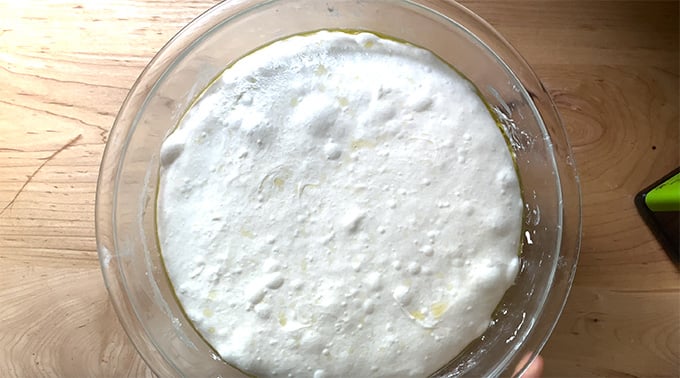
Transfer the dough to a buttered + olive oiled pan. If you are certain your dough will not stick to the pan you are using, you can get away with olive oil alone, but if there is any question, butter the pan first — it will ensure your dough will release without issue. Let the dough rise for 3 to 5 hours or until it looks like …

… this.

In the meantime, gather your ingredients for the topping: garlic, anchovies, olives, capers, olive oil, tomatoes, and onions.
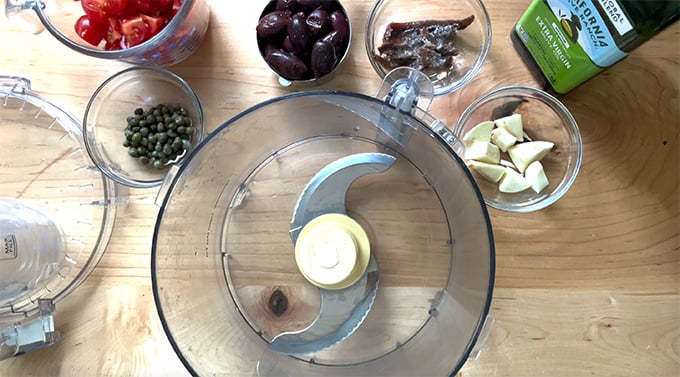
Make a coarse purée with the olives, garlic, capers, anchovies, and olive oil.

Sauté the onions until lightly golden, about 15-20 minutes over medium to low heat.

Then layer the toppings over the dough as follows: onions, olive purée, tomatoes.

Dimple one last time; them transfer to the oven immediately. Bake until evenly golden, about 25 minutes.
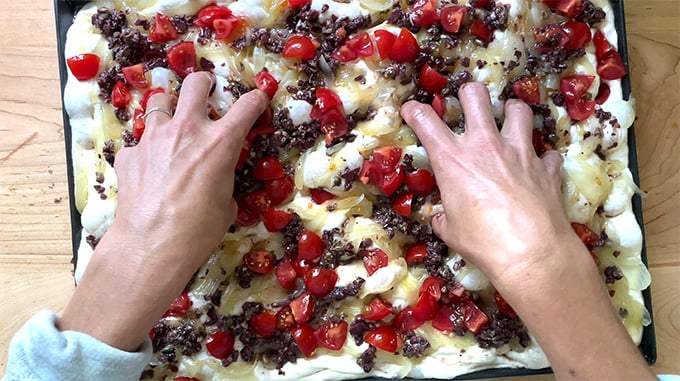


Cut into squares; serve warm or at room temperature.
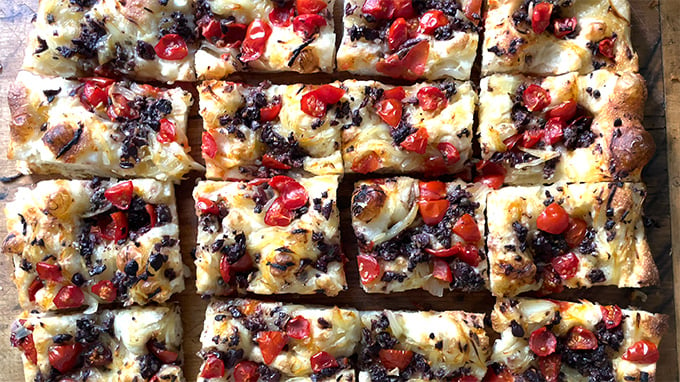
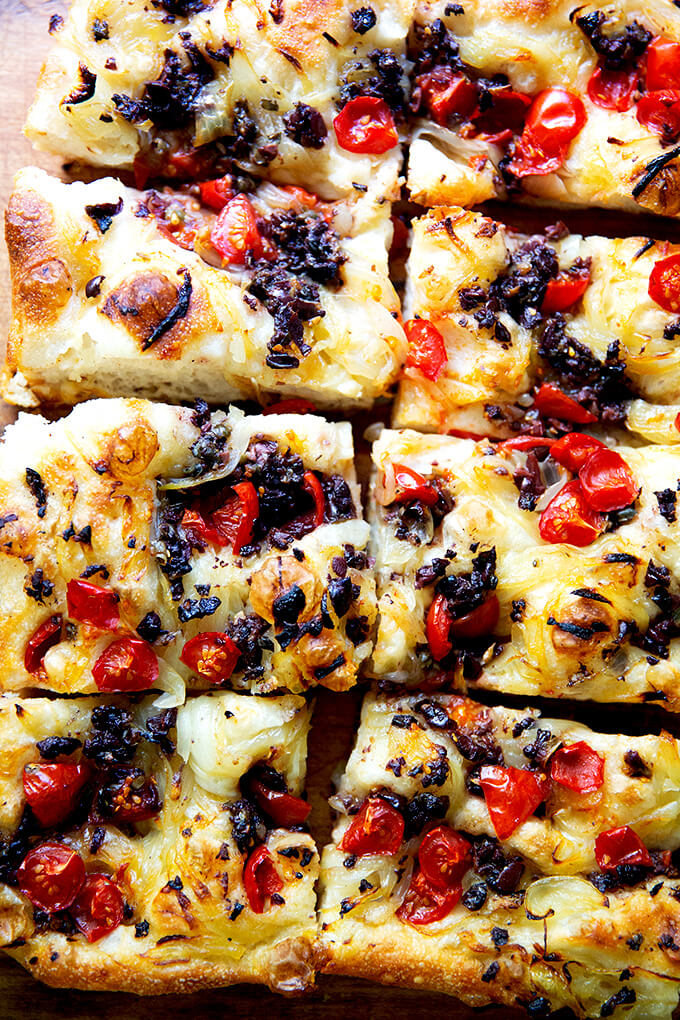

How to Make Pissaladière
- Total Time: 24 hours 25 minutes
- Yield: Serves 8 to 10
Description
Adapted from my cookbook, Bread Toast Crumbs. In my cookbook, I make the pissaladière start to finish in just about 3 hours. In this updated version, I call for either an overnight, refrigerated focaccia (yeasted) or a sourdough focaccia, both of which were adapted from the BTC focaccia recipe. If you’d like to make this in a more timely manner, find the BTC recipe on Taste Cooking.
The pan: Any standard sized half sheet pan will work here. My recent interest in Detroit-style pizza led me to discover this Lloyd “Gramma” style pan, which I am loving.
Ingredients
The Dough:
- yeasted focaccia, made through step 1
- sourdough focaccia, made through step 3
For assembly:
- 6 tablespoons extra-virgin olive oil, plus more for greasing
- 3 cups sliced onions (about 3 medium onions, halved and thinly sliced)
- pinch of kosher salt
- 2 garlic cloves
- 4 anchovies
- 1 tablespoon capers
- ½ cup coarsely chopped pitted kalamata or niçoise olives
- 1 cup diced tomatoes
Instructions
- Make your focaccia dough through step 1 for the overnight refrigerator focaccia and through step 3 for the sourdough focaccia.
- For the pissaladière toppings: In a large sauté pan, heat 2 tablespoon olive oil over high heat. When it begins to shimmer, add the onions and a pinch of salt. Cover; then immediately reduce the heat to low and cook, stirring every few minutes, until the onions are lightly golden, about 15 to 20 minutes.
- Meanwhile, in a food processor, mince the garlic and anchovies together. Add 2 tablespoons of oil and blend until smooth. Add the capers and pulse to coarsely chop. Add the olives and pulse again to coarsely chop. Set aside.
- Line a rimmed sheet pan with parchment paper or coat with butter or nonstick cooking spray. Pour the remaining 2 tablespoons oil on the sheet pan. Using lightly greased hands, deflate the dough by releasing it from the sides of the bowl. Again, using your hands, shape the dough into a rough ball or rectangle; then transfer it to the prepared sheet pan. Roll the dough ball in the oil to coat it all over. Let it rest without touching it for 3 to 5 hours or until the dough has puffed considerably and is filling the pan.
- Set a rack in the middle of the oven and preheat it to 425°F.
- With lightly greased hands, press down on the dough, using all 10 fingers to dimple and stretch the dough outward. Pull gently on the ends and stretch them toward the corners of the sheet pan. When the dough begins to resist being stretched, let it rest for 5 minutes, then stretch it again, continuing until it fits most of the sheet pan.
- Spread the sautéed onions over the dough. Top with the anchovy puree. Finally, scatter the tomatoes over top. Use all 10 fingers again to dimple the dough and gently stretch it.
- Transfer the sheet pan to the oven and bake for 25 to 30 minutes, until the underside is golden and crisp. Remove the pissaladière from the oven and transfer it to a cutting board. Let it cool for 10 minutes before cutting it into squares.
- Prep Time: 24 hours
- Cook Time: 25 minutes
- Category: Bread
- Method: Oven
- Cuisine: American, French
This post may contain affiliate links. Please read my disclosure policy.












50 Comments on “How to Make Pissaladière”
That is a GORGEOUS creation that I will definitely be making. Question: where do I get a pizza cutter like that? Such an interesting-looking tool!
Hi Katy! I bought mine from Amazon, but I don’t love it. It’s not sharp enough. A few people have sent me recommendations for similarly shaped cutters that they like as well as pizza scissors — I’ve ordered one of each and will report back with the results soon … stay tuned!
✂️🙌 Pizza scissors are brilliant 🙌✂️
Right?! I can’t wait for mine to arrive.
Do you think you would ever add cheese to the Pissaldière (although this maybe sacrilege) and if so what wld you recommend. 😁
Not sacrilege at all! I think that sounds delicious. Part of me thinks cubes of fontina or mozzarella would be really good. Something like parmesan would probably be too salty, so, I’m leaning more towards suggesting those melty, creamy cheeses. I also think dollops of creme fraiche would be delicious. Go for it!
Baked and devoured! Delicious and enjoyed by all in the house aged 75 to 13. Winner.
Oh yay! Wonderful to hear this, Fiona 🙂 🙂 🙂 Thanks so much for writing!
Alex,
I am wondering if you have use brined or oil/herb kalamata olives in your focaccias. Since in this case you chop them I assume it doesn’t matter but I think I am going to push whole or halves in your yeasted focaccia and not sure if the oil ones will stay put as well as the plain brined type although they are tastier! Thank you.
Hi Denise! I think the oily, herbed olives will stay put just fine! Go for it! I have not tried, but I wouldn’t hesitate to use them. Good luck!
Delicious! But the top of my focaccia came out too wet. I wonder if I used too many onions. Will try again with less.
Hi Kim! Great to hear. The top of mine often is a little wet, too — I don’t mind this, but I could see how others would prefer a crisper texture. I think fewer onions will do the trick. Thanks for writing!
I needed a bit more water because I used chapattis flour ,it turned out awesome !
Great to hear! Thanks so much for writing. Glad you were able to adjust and make it work with your flour!
I use an ulu that I bought in Alaska for cutting pizza. Works great.
Oh, awesome! Thanks for the tip. I’ll look into that … never heard of an ulu!
Question. When making the foccacia recipe you use the entire dough recipe in one 9×13 pan or 2 pie pans. For the pissaladiere you recommend a sheet pan. . Is the intent for the pissaladiere to have a thinner bread layer than foccacia?
Yes, exactly!
I made this recipe with the sourdough focaccia as the base, and it was incredible. It’s starting to get chilly in the northeast, so my first rise took 14 hours and second about 4. The bread didn’t last longer than 12 hours in our house because it was such a hit!
Oh yay! Wonderful to hear this, Caroline! Thanks so much for writing and sharing your notes … my bread is taking SO much longer to rise these days as well. Stay cozy!
Thank you for sharing this absolutely delicious recipe! I could eat the entire pan myself. Of course, I decided to change it up a bit. I love Sicilian pizza with its thick crust, so I baked it in a 13x9x2 pan, sticking to your foccacia recipe. I didn’t make a paste of the olives, capers and garlic, since I’m not a garlic fan. I chopped the olives and blotted them as well as the onions with a few layers of paper towels after the other commenter wrote about it being a bit wet on top. I sprinkled it with coarse sea salt and rosemary and baked. Heaven!!
Oh yay! So great to hear this, Donna 🙂 🙂 🙂 Thanks so much for writing and sharing all of your notes, especially about blotting the onions and olives… smart! I love Sicilian pizza, too, so this sounds heavenly to me.
Dearest Alexadra,
First of all Happy New Year to you and your family. Second, I’d like to thank you for this incredible recipe. I made it using my sourdough starter. I’ve made your Focaccia recipe many time but decided to try this to change it up. Well, let me just say I’m incredibly impressed with myself hahaha! I think my family should be giving me a standing ovation for this incredible masterpiece! It’s delicious and I made it exactly the way you instructed. Thank you, thank you, thank you!!!
Cheers!
Rose
So wonderful to hear this, Rose! The combination of sweet and salty here is heaven to me, too. Wishing you a happy happy New Year! Thanks so much for writing 🙂 🙂 🙂
I am wondering what would be good to serve with this? It seems hearty/strongly flavored enough to not need a dipping oil/spread/filling. I am wanting to make it for a dinner.
Hi! Honestly, I think a big salad on the side is all it needs. Maybe this kale salad without the bread crumbs?
I used the pissaladiere toppings instead on your simple sourdough pizza recipe and it was a big hit! My question today, though, is on how to adapt the yeast-risen recipes in your “Bread, Toast, Crumbs” book to use sourdough instead. Is there a standard algorithm for replacing yeast with sourdough that I I can apply to these recipes?
Great to hear Cathy! Thanks for writing. I find using 100 grams of starter is about right, and I omit the sugar, and then I let time take its course. When nuts and dried fruit and other add-ins make their way into the recipe, I add them after I do a few sets of stretches and folds. Hope this make sense!
I made this recently with a few variations and it was sensational!! I could not believe how good it was. The sweetness of the onions contrasting with the saltiness of the anchovies and olives works perfectly, then these are set off by the onions. And the focaccia base is EXACTLY right for it.
The variations were basically to avoid using the food processor and having to clean it. Essentially what I did was cut up the tomatoes, olives (halved) and anchovies and mix them all together with the capers, then spread the whole lot over the onions. It worked a treat and looked every bit as appetising as Alexandra’s.
Wonderful to hear this, Robin! Love the idea of not having to dirty the food processor when it can be done just as easily and well with a little elbow grease 🙂 🙂 🙂 Thanks so much for writing and sharing your notes. I love the combo of the sweet onions and tomatoes with all the salty bits, too.
Thanks for your tip. I think I’ll try to avoid the food processor.
Just finished making this. Sooooo good! Will be one of my favorites!
Great to hear, Lisa! Thanks so much for writing 🙂 🙂 🙂
You are so inspiring and this focaccia is a work of art. I’ve made it a few times and it is one of my all time favorites but tonight I’m attempting Muffuletta olive salad topping ( actually making a plain rosemary garlic and the olive topping) Fingers crossed :). Thank you for all your delicious recipes and helping me feed my family happy!!!
So nice to read this, Liane!! Thank you :). A few years ago I used the focaccia to make Muffuletta sandwiches, and they were so good. I need to do it again. I loved the olive salad that was loaded with other things too (cauliflower, carrots, … I can’t remember). Hope yours turned out great!
Hi. Would this work in a 13×9 USA pan instead of a sheet pan?
Yes! It will just be thicker. If you are fine with a thicker base, go for it!
I was wondering if you can refrigerate the pissaladiere overnight and bake it in the morning for a brunch?
Yes, absolutely, go for it! Be sure the dough or the pan is covered tightly with plastic wrap to ensure it doesn’t dry out.
Should the toppings be put on the dough in the pan first in the morning? And when shall I dimple the pissaladiere? In the morning or in the evening? I’m definitely going to bake this. Sorry for my English.
But the toppings on right before baking it.
Ali,
May I suggest that you make a correction to #4 in the instructions? I think that pre-heating the oven closer to the time the dough has risen (3-5 hour period) would be more appropriate.
Turning the page: I made this recipe three times last week … would have made it again, except I was out of bread flour! I shared the last batch, using two 9×9 pans, with some friends. We had one pan with our salad, and I left the second pan with our host who really liked it. The next day, it was shared with the daughter who declared, “if she was to request something for her last meal on earth, she would request my focaccia (aka Pissaladiere).”
Wishing you continued success!
Great suggestion, Jan! I just edited the recipe. Thank you 🙂 And yay for everything else you wrote, too! I’m so happy to hear this, I made this for a potluck recently, and it reminded me how much I love it. Thanks for writing!
Very forgiving dough! I left in fridge for 5.5 days.
Rose beautifully.
I did use 4 times as many anchovies- next time i would have only made the 4 into the paste and left the rest in chunks for texture. But we love anchovies here lol
So delicious! Will make thicker focaccia size next time as well!
Great to hear, Johanna! I would LOVE 4x anchovies. Thanks for writing 🙂
My bread is in the refrigerator “doing its thing “ and I realize that this is going to make a really big pissaladiere. Can I freeze half of the dough for another time? I can’t wait to make this, it looks awesome!
Yes! Hope you love it 🙂
Previously, I had commented on freezing half of the dough because I thought it would be too big but the two of us managed to finish quite a bit of it! The only thing I changed was to add some chopped Italian salami, and took another reviewers suggestion to add rosemary and sea salt before baking.
I used a half sheet pan which resulted in a thinner pissaladiere with a crispy crust but never got that beautiful dimpled look. I have a pan that’s somewhere between a 9×13 and a half sheet pan so I’ll try that next time. And there will be a next time! Delicious!
Great to read all of this, Kathy 🙂 🙂 🙂 All of your additions sound delicious, and I think the slightly larger pan will help create the dimpled look you are after. Thanks for writing!